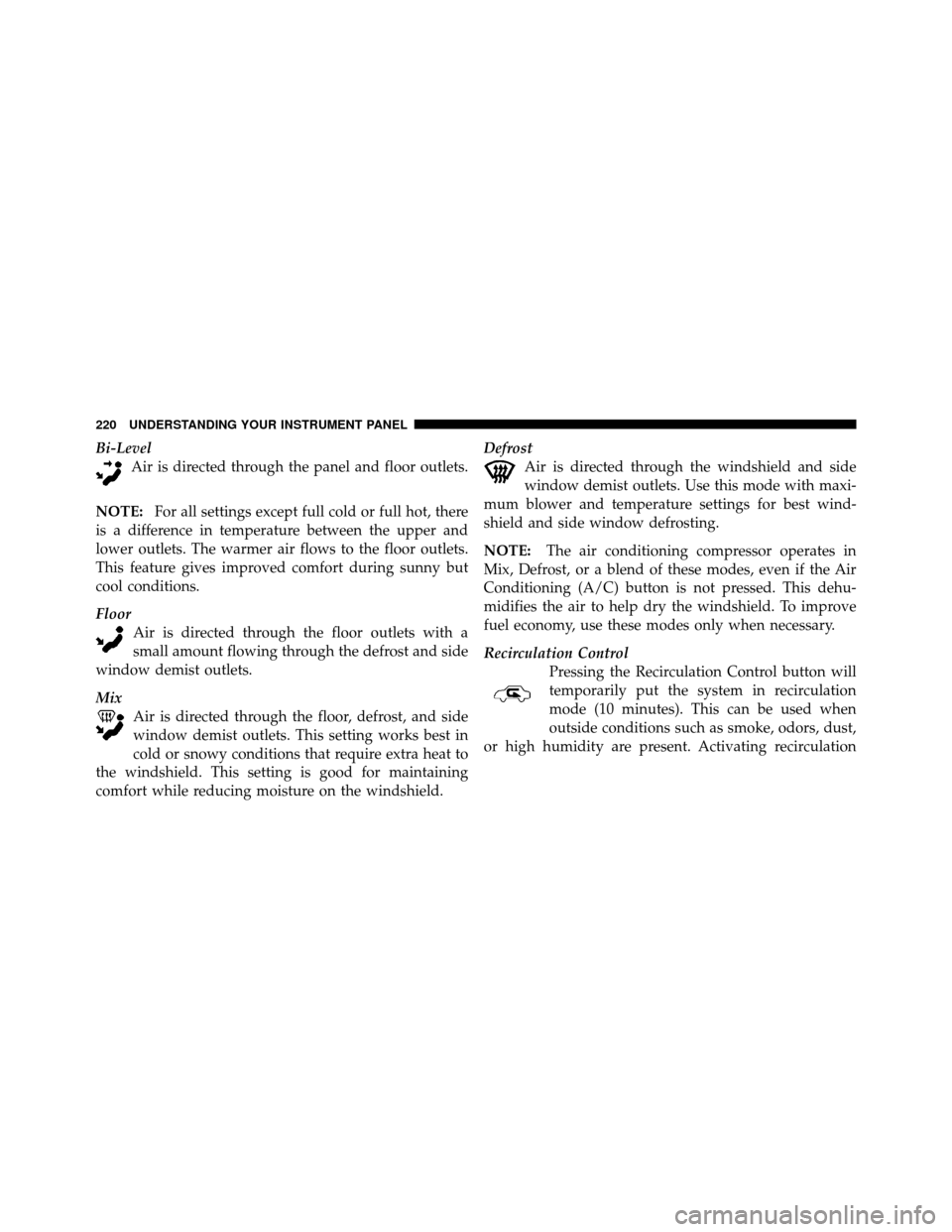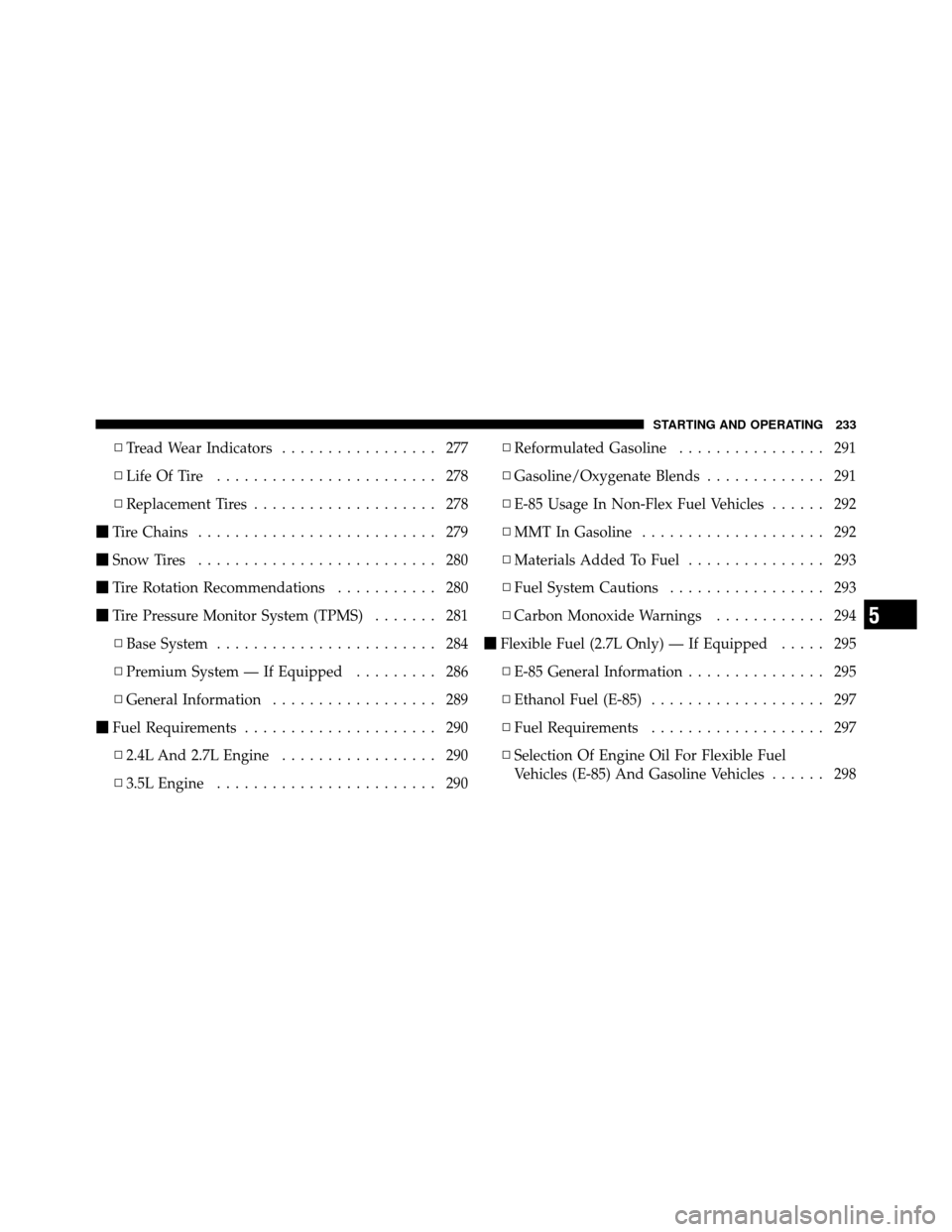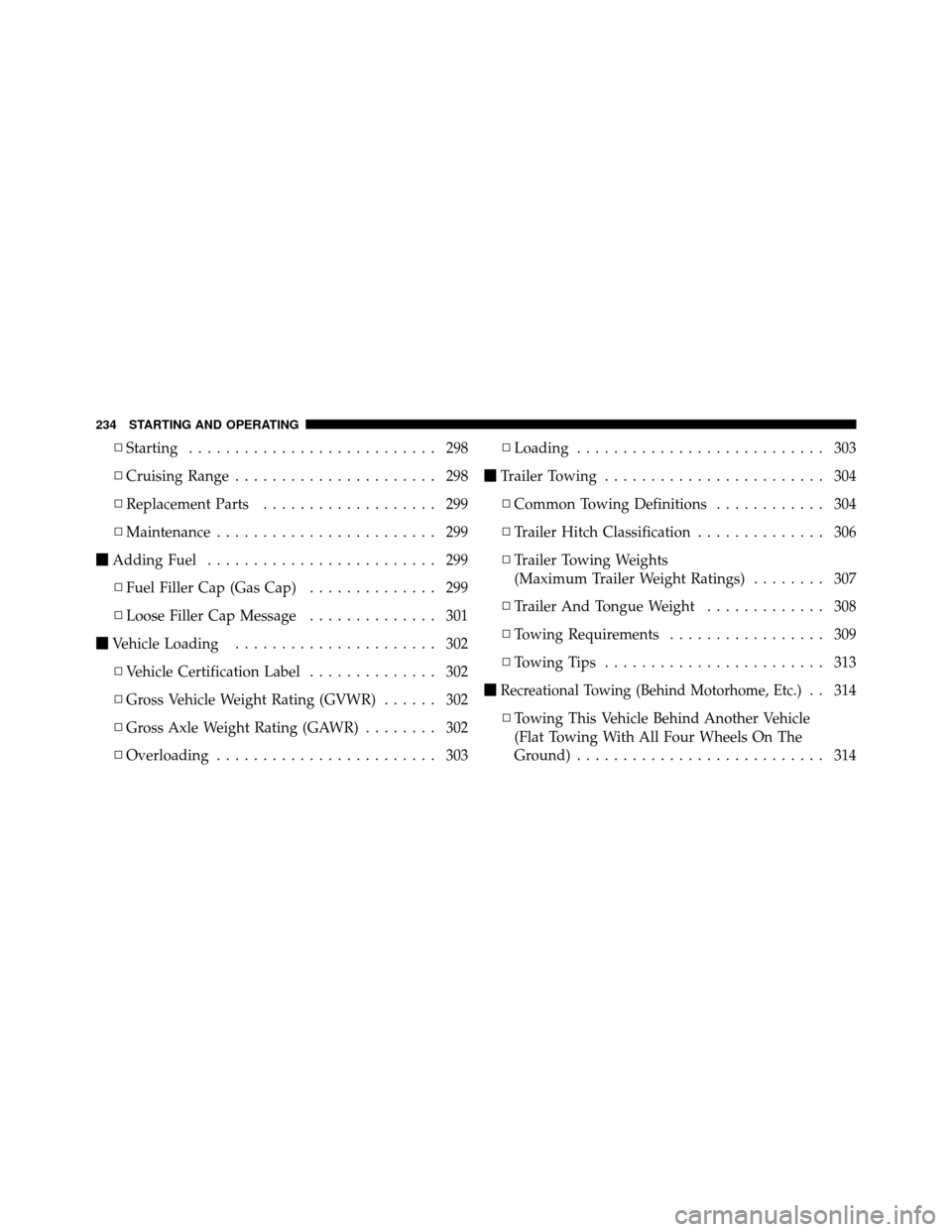Page 158 of 436

CAUTION!
Prolonged driving with the MIL on could cause
damage to the engine control system. It also could
affect fuel economy and drivability. If the MIL is
flashing, severe catalytic converter damage and
power loss will soon occur. Immediate service is
required.
WARNING!
A malfunctioning catalytic converter, as referenced
above, can reach higher temperatures than in normal
operating conditions. This can cause a fire if you
drive slowly or park over flammable substances such
as dry plants or wood or cardboard, etc. This could
result in death or serious injury to the driver, occu-
pants or others.27. Transmission Temperature Indicator — If Equipped
During sustained high speed driving on hot
days, the automatic transmission oil may be-
come too hot. If this happens, the transmission
overheat indicator light will come on and the
vehicle will slow slightly until the automatic transmis-
sion cools down enough to allow a return to the re-
quested speed. If the high speed is maintained, the
overheating will reoccur as before in a cyclic fashion.
CAUTION!
Continuous driving with the Transmission Tempera-
ture Indicator illuminated will eventually cause se-
vere transmission damage or transmission failure.
158 UNDERSTANDING YOUR INSTRUMENT PANEL
Page 161 of 436
Press and release the RESET button to accept a
selection. The RESET button also resets various
Trip Functions.
Electronic Vehicle Information Center (EVIC)
Displays
When the appropriate conditions exist, the EVIC displays
the following messages.
•Turn Signal On (with a continuous warning chime
after one mile traveled)
•Left Front Turn Signal Light Out (with a single chime)
•Left Rear Turn Signal Light Out (with a single chime)
•Right Front Turn Signal Light Out (with a single
chime)
•Right Rear Turn Signal Light Out (with a single chime)
•RKE (Remote Keyless Entry) Battery Low (with a
single chime)
•Personal Settings Not Available – Vehicle Not In PARK
•Personal Settings Not Available – Vehicle in Motion
•Door(s) Ajar (with a single chime if vehicle is in
motion)
•Trunk Ajar (with a single chime)
•Headlights On
•Key In Ignition
•Oil Change Required (with a single chime)
•ECO (Fuel Saver Indicator) — If Equipped
RESETButton
4
UNDERSTANDING YOUR INSTRUMENT PANEL 161
Page 162 of 436

Oil Change Required
Your vehicle is equipped with an engine oil change
indicator system. The Oil Change Required message will
flash in the EVIC display for approximately five seconds
after a single chime has sounded to indicate the next
scheduled oil change interval. The engine oil change
indicator system is duty cycle based, which means the
engine oil change interval may fluctuate dependent upon
your personal driving style.
Unless reset, this message will continue to display each
time you turn the ignition switch to the ON/RUN
position. To turn off the message temporarily, press and
release the MENU button. To reset the oil change indica-
tor system (after performing the scheduled maintenance)
perform the following procedure:
1. Turn the ignition switch to the ON position (Do not
start the engine).2. Fully depress the accelerator pedal slowly three times
within 10 seconds.
3. Turn the ignition switch to the LOCK position.
NOTE:
If the indicator message illuminates when you
start the vehicle, the oil change indicator system did not
reset. If necessary repeat this procedure.
Trip Functions
Press and release the MENU button until one of the
following Trip Functions displays in the EVIC:
•ECO (Fuel Saver Indicator) — If Equipped
•Average Fuel Economy
•Distance To Empty
•Elapsed Time
•Display Units of Measure in
162 UNDERSTANDING YOUR INSTRUMENT PANEL
Page 163 of 436

Press and release the STEP button to advance the display
through the Trip Functions.
The Trip Functions mode displays the following informa-
tion:
•ECO (Fuel Saver Indicator) — If Equipped
The ECO indicator will illuminate in the EVIC display.
This ECO message will appear when you are driving in a
fuel efficient manner and can be used to modify driving
habits in order to increase fuel economy.
•Average Fuel Economy
Shows the average fuel economy since the last reset.
When the fuel economy is reset, the display will read,
RESET or show dashes for two seconds. Then, the history
information will be erased, and the averaging will con-
tinue from the last fuel average reading before the reset.
•Distance To Empty (DTE)
Shows the estimated distance that can be traveled with
the fuel remaining in the tank. This estimated distance is
determined by a weighted average of the instantaneous
and average fuel economy, according to the current fuel
tank level. DTE cannot be reset through the RESET
button.
NOTE: Significant changes in driving style or vehicle
loading will greatly affect the actual drivable distance of
the vehicle, regardless of the DTE display value.
When the DTE value is less than 30 miles (48 km)
estimated driving distance, the DTE display will change
to a text display of �LOW FUEL”. This display will
continue until the vehicle runs out of fuel. Adding a
significant amount of fuel to the vehicle will turn off the
LOW FUEL text and a new DTE value will display.
4
UNDERSTANDING YOUR INSTRUMENT PANEL 163
Page 220 of 436

Bi-LevelAir is directed through the panel and floor outlets.
NOTE: For all settings except full cold or full hot, there
is a difference in temperature between the upper and
lower outlets. The warmer air flows to the floor outlets.
This feature gives improved comfort during sunny but
cool conditions.
Floor Air is directed through the floor outlets with a
small amount flowing through the defrost and side
window demist outlets.
Mix Air is directed through the floor, defrost, and side
window demist outlets. This setting works best in
cold or snowy conditions that require extra heat to
the windshield. This setting is good for maintaining
comfort while reducing moisture on the windshield. Defrost
Air is directed through the windshield and side
window demist outlets. Use this mode with maxi-
mum blower and temperature settings for best wind-
shield and side window defrosting.
NOTE: The air conditioning compressor operates in
Mix, Defrost, or a blend of these modes, even if the Air
Conditioning (A/C) button is not pressed. This dehu-
midifies the air to help dry the windshield. To improve
fuel economy, use these modes only when necessary.
Recirculation Control Pressing the Recirculation Control button will
temporarily put the system in recirculation
mode (10 minutes). This can be used when
outside conditions such as smoke, odors, dust,
or high humidity are present. Activating recirculation
220 UNDERSTANDING YOUR INSTRUMENT PANEL
Page 233 of 436

▫Tread Wear Indicators ................. 277
▫ Life Of Tire ........................ 278
▫ Replacement Tires .................... 278
� Tire Chains .......................... 279
� Snow Tires .......................... 280
� Tire Rotation Recommendations ........... 280
� Tire Pressure Monitor System (TPMS) ....... 281
▫ Base System ........................ 284
▫ Premium System — If Equipped ......... 286
▫ General Information .................. 289
� Fuel Requirements ..................... 290
▫ 2.4L And 2.7L Engine ................. 290
▫ 3.5L Engine ........................ 290 ▫
Reformulated Gasoline ................ 291
▫ Gasoline/Oxygenate Blends ............. 291
▫ E-85 Usage In Non-Flex Fuel Vehicles ...... 292
▫ MMT In Gasoline .................... 292
▫ Materials Added To Fuel ............... 293
▫ Fuel System Cautions ................. 293
▫ Carbon Monoxide Warnings ............ 294
� Flexible Fuel (2.7L Only) — If Equipped ..... 295
▫ E-85 General Information ............... 295
▫ Ethanol Fuel (E-85) ................... 297
▫ Fuel Requirements ................... 297
▫ Selection Of Engine Oil For Flexible Fuel
Vehicles (E-85) And Gasoline Vehicles ...... 298
5
STARTING AND OPERATING 233
Page 234 of 436

▫Starting ........................... 298
▫ Cruising Range ...................... 298
▫ Replacement Parts ................... 299
▫ Maintenance ........................ 299
� Adding Fuel ......................... 299
▫ Fuel Filler Cap (Gas Cap) .............. 299
▫ Loose Filler Cap Message .............. 301
� Vehicle Loading ...................... 302
▫ Vehicle Certification Label .............. 302
▫ Gross Vehicle Weight Rating (GVWR) ...... 302
▫ Gross Axle Weight Rating (GAWR) ........ 302
▫ Overloading ........................ 303 ▫
Loading ........................... 303
� Trailer Towing ........................ 304
▫ Common Towing Definitions ............ 304
▫ Trailer Hitch Classification .............. 306
▫ Trailer Towing Weights
(Maximum Trailer Weight Ratings) ........ 307
▫ Trailer And Tongue Weight ............. 308
▫ Towing Requirements ................. 309
▫ Towing Tips ........................ 313
�
Recreational Towing (Behind Motorhome, Etc.). . 314
▫ Towing This Vehicle Behind Another Vehicle
(Flat Towing With All Four Wheels On The
Ground) ........................... 314
234 STARTING AND OPERATING
Page 236 of 436
For vehicles equipped with Tip Start (Six-Speed Trans-
axle),turn the ignition switch to the START position and
release it as soon as the starter engages. The starter motor
will continue to run, and it will disengage automatically
when the engine is running. If the engine fails to start, the
starter will disengage automatically in 10 seconds. If this
occurs, turn the ignition switch to the LOCK position,
wait 10 to 15 seconds, then repeat the “Normal Starting”
procedure.
Extreme Cold Weather (Below �20°F or�29°C)
To ensure reliable starting at these temperatures, use of
an externally powered electric engine block heater (avail-
able from your dealer) is recommended.
If Engine Fails To Start
WARNING!
•Never pour fuel or other flammable liquids into
the throttle body air inlet opening in an attempt to
start the vehicle. This could result in a flash fire
causing serious personal injury.
(Continued)
236 STARTING AND OPERATING